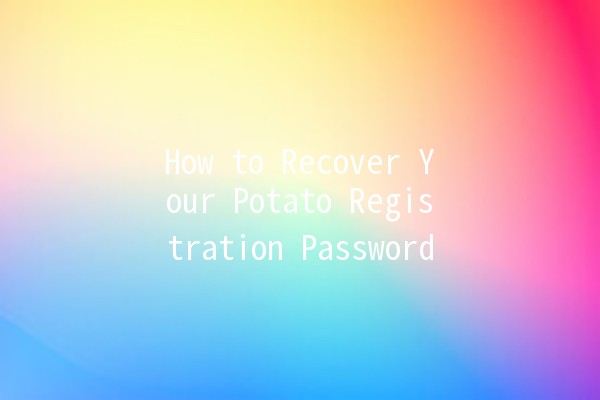Recovering a forgotten password can be a frustrating task, but it's an essential skill in today's digital age. Whether it's for your Potato registration or another service, knowing how to regain access is paramount. In this article, we'll explore effective methods to recover your Potato password and share productivityboosting tips to help you manage your online accounts more effectively.
Understanding the Importance of Password Management
In our increasingly digital lives, passwords serve as the gatekeepers to our personal information. A secure password protocol is essential to protect against unauthorized access. Regularly updating your passwords and having a system for recovering them can save you time and stress.
Why You Might Forget Your Password
Multiple Accounts: With so many accounts requiring unique passwords, it's easy to forget one among the many.
Infrequent Use: If you haven't used your Potato account in a while, the password can slip your mind.

Lack of Organization: Without a structured method for managing passwords, retrieval can become chaotic.
Understanding the underlying reasons for forgotten passwords can help in devising better management strategies.
Steps for Recovering Your Potato Registration Password
Most platforms, including Potato, have a builtin 'Forgot Password' feature that simplifies the recovery process. Here's how you can use it:
Occasionally, additional identity verification may be necessary:
After successfully resetting your password, take a moment to review your security settings:
Enable TwoFactor Authentication: This adds an extra layer of protection.
Update Security Questions: Ensure that your security questions are current and something only you would know.
If you're still unable to recover your password, reaching out to Potato's customer support may be your best option. They can provide additional assistance, but make sure you have:
Account Information: Be ready to provide any necessary information that proves your identity.
Details of Your Attempt: Inform them of the steps you've already taken to recover your password.
Once you've regained access to your Potato account, consider using a password manager. This tool can help you generate, store, and manage your passwords securely. Plus, most password managers can autofill logins, making your online experience smoother.
ProductivityCentric Strategies for Managing Passwords
Managing passwords effectively can save time and enhance productivity. Here are five strategies to boost your efficiency when dealing with online accounts:
Use phrases or a combination of unrelated words to create a strong password that is easy to remember. For instance, “Biscuit7Dinosaur@Lunch” is more secure than a simple word and still somewhat memorable.
Establish a routine for updating your passwords every three to six months. Setting calendar reminders can help you stick to this important practice.
Avoid using the same password across multiple platforms. This way, if one account becomes compromised, your other accounts remain secure.
If you prefer not to use a password manager, write down your passwords in a secure place, like a locked drawer. Alternatively, consider using a secure notes application with encryption to keep your passwords safe.
Keeping up with the latest in cybersecurity can help you recognize threats before they affect you. Follow reputable tech blogs or subscribe to newsletters from security experts to receive timely updates.
Common Questions About Password Recovery
If you don’t see the password reset email, check your spam folder and ensure you entered the correct email address. If not, try resending the request and ensure you monitor your inbox closely.
It's advisable to change your passwords every 3 to 6 months. Regular changes help mitigate risks, especially if you've used the same passwords for extended periods.
Yes, reputable password managers use strong encryption to protect your data. They also minimize the risk of phishing attacks since they fill in passwords automatically on recognized sites.
Twofactor authentication (2FA) requires you to provide two forms of identification before accessing an account, usually something you know (like your password) and something you have (like a phone). Enabling 2FA significantly increases your account security.
While following best practices greatly reduces your risk, no system is entirely hackproof. Regularly monitoring your accounts for suspicious activity is crucial.
Immediately change your password and notify Potato's support team. Enable twofactor authentication if you haven't already, and monitor your other accounts for any suspicious activity.
al Thoughts
Navigating password recovery might be daunting, but with the right tools and strategies, you can manage your online accounts effectively. From utilizing the builtin recovery options to employing productivityboosting practices, taking control of your password management will enhance your online security and save you time. Embrace technology and stay informed, and you'll ensure a seamless digital experience.